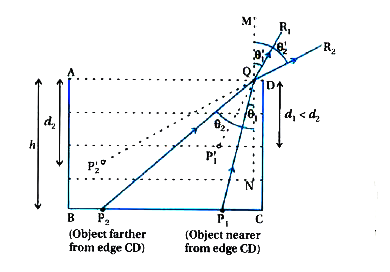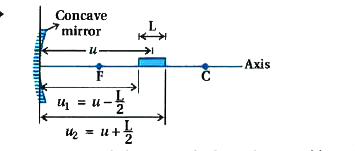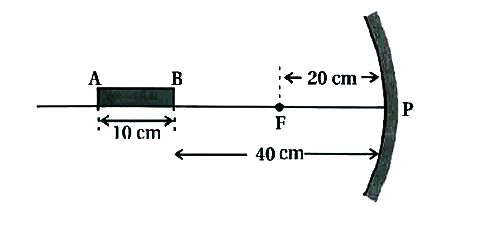Consider an extended object immersed in water contained in a plane trough. When seen from close to the edge of the trough the object looks distorted becauseSolution in Gujrati
the apparent depth of the points close to the edge are nearer the surface of the water compared to the points away from the edge.
the angle subtended by the image of the object at the eye is smaller than the actual angle subtended by the object in air.
some of the points of the object far awa from the edge may not be visible because total internal reflection.
water in a trough acts as a lens an magnifies the object.
The correct Answer is:A, B, C

Consider a plane trough (a long and shallow water reservoir with plane bottom) with AD a water surface. Now, observe point like objects P1 and P2, at equal depth AB = CD = h obliquely a point Q, nearer to edge CD. Here, for incidence ray P1Q, angle of incidence is θ1. and angle o refraction is θ.1. Similarly, for incident ray vac(P2Q) angle of incidence is θ2, and angle of refraction is θ.2 . Here because of refraction at surface AD of water, we get θ.1>θ1 and θ.2>θ2. Here theat2>θ1 and so we get θ.2>theat.1 . Because of this virtual depths of virtual positions P.1 and P.2 (of real objects, respectively P1 and P2.) are obtained as d1 and d2 where d1<d2 as seen from the figure)
Thus virtual depth is found to be less nearer the edge of trough and farther the edge of trough, it is found to be more.
Now, here if object is an extended object, extended from P1 to P2 then due to same depth, object is actually planar but when it is observed from near the edge of water surface in a trough image of planar object appears to be distorted. Thus, option (A) is correct.
Now, as per the statement if we consider object in air at R1, near the water surface then its real image is formed at point P1. Here ∠R1QM=θ.1 and ∠P1QN=θ1 where θ1<θ.1
⇒ Option (B) is also correct.
Now, in above figure if we shift point-like object towards end B then angle of incidence θ goes on increasing. At one stage when θ≥C (where C = critical angle), object is not seen from air due to total internal reflection. Thus, option (C) is also correct.
Topper's Solved these Questions
- BOOK - KUMAR PRAKASHANCHAPTER - RAY OPTICS AND OPTICAL INSTRUMENTSEXERCISE - SECTION-C (NCERT EXEMPLAR SOLUTION) (VERY SHORT ANSWER TYPE QUESITONS)5videos
RAY OPTICS AND OPTICAL INSTRUMENTS
- BOOK - KUMAR PRAKASHANCHAPTER - RAY OPTICS AND OPTICAL INSTRUMENTSEXERCISE - SECTION-C (NCERT EXEMPLAR SOLUTION) (SHORT ANSWER TYPE QUESITONS)6videos
RAY OPTICS AND OPTICAL INSTRUMENTS
- BOOK - KUMAR PRAKASHANCHAPTER - RAY OPTICS AND OPTICAL INSTRUMENTSEXERCISE - SECTION-B (NUMERICALS)(NUMERICAL FROM .DARPAN. BASED ON TEXTBOOK )12videos
RAY OPTICS AND OPTICAL INSTRUMENTS
- BOOK - KUMAR PRAKASHANCHAPTER - MOVING CHARGES AND MAGNETISMEXERCISE - SECTION D (MCQs ASKED IN COMPETITIVE EXAMS)34videos
MOVING CHARGES AND MAGNETISM
- BOOK - KUMAR PRAKASHANCHAPTER - SAMPLE QUESTION PAPER EXERCISE - PART-B SECTION-C5videos
SAMPLE QUESTION PAPER
Similar Questions
Will the focal length of a lens for red light be more, sam or less than that for blue light
01:37View SolutionA short object of length L is placed along the principal axis of a concave mirror away from focus. The object distance is u. If the mirror has a focal length f, what will be the length of the image ? You may take L<<|v−f|.
 01:59View Solution
01:59View SolutionAs shown in the figure, a thin rod AB of length 10 cm is placed on the principal axis of a concave mirror such that it.s end B is at a distance of 40 cm from the mirror. If the focal length of the mirror is 20 cm, find the length of the image of the rod
 03:44View Solution
03:44View SolutionElectric charge Q having mass M moves on a circular path of radius R with velocity →v, perpendicular to uniform magnetic field B. When a particle completes one revolution, work done by the field is _______
02:50View SolutionTwo charges –q and +q are located at points (0, 0, –a) and (0, 0, a), respectively.
(a) What is the electrostatic potential at the points (0, 0, z) and (x, y, 0) ?
(b) Obtain the dependence of potential on the distance r of a point from the origin when r/a>>1 .
(c) How much work is done in moving a small test charge from the point (5,0,0) to (–7,0,0) along the x-axis? Does the answer change if the path of the test charge between the same points is not along the x-axis?02:22View SolutionA steel ball is floating in a trough of mercuty. If we fill the empty part of the trough with water, what will happen to the steel ball ?
View SolutionAn ice cube containing a galss ball is floating on the surface of water contained in a trough. The whole of the ice melts, the level of water in the trough
02:43View SolutionConsider an extended object immersed in water contained in a plane through. When seen from close to the edge of the through, the object looks distorted because.
View Solutionनाभिकीय रिऐक्टरों में भारी जल का उपयोग न्यूट्रॉन मन्दक के रूप में किया जाता है।
02:26View SolutionWhen a glass lens with μ = 1.47 is immersed in a trough of liquid, it looks to be disappeared. The liquid in the trough could be
01:29View SolutionAn extended object kept under water in a deep container appears distorted when seen from near the edge of the container. It so happens because
04:26View SolutionWhen a glass lens with μ=1.47 is immersed in a troug of liquid, it looks to be disappeared. The liquid in the trough could be
03:27View SolutionConsider an extended object immersed in water contained in a plane trough. When seen from close to th edge of the through the object looks distroted because
03:23View Solutionकिसी समतल द्रोणी में लिए गए जल में डूबे एक विस्तरित बिम्ब का विचार कीजिए। जब द्रोणी की कोर को समीप से देखा जाता है तो बिम्ब विकृत दिखाई देता है, क्योंकि
02:26View SolutionAn object looks red when seen through a piece of red glass. What is the actual colour of the object?
05:03View Solution

